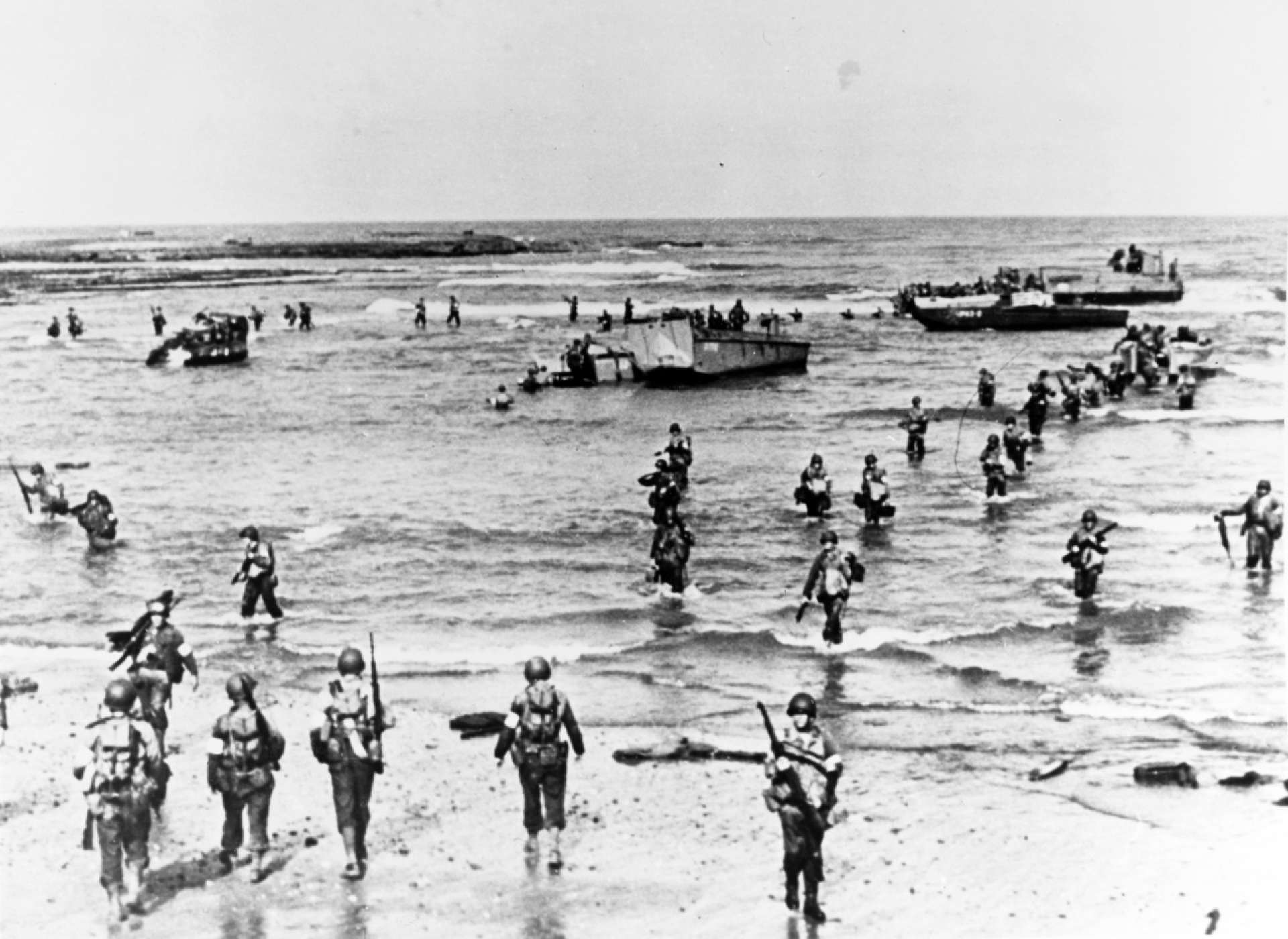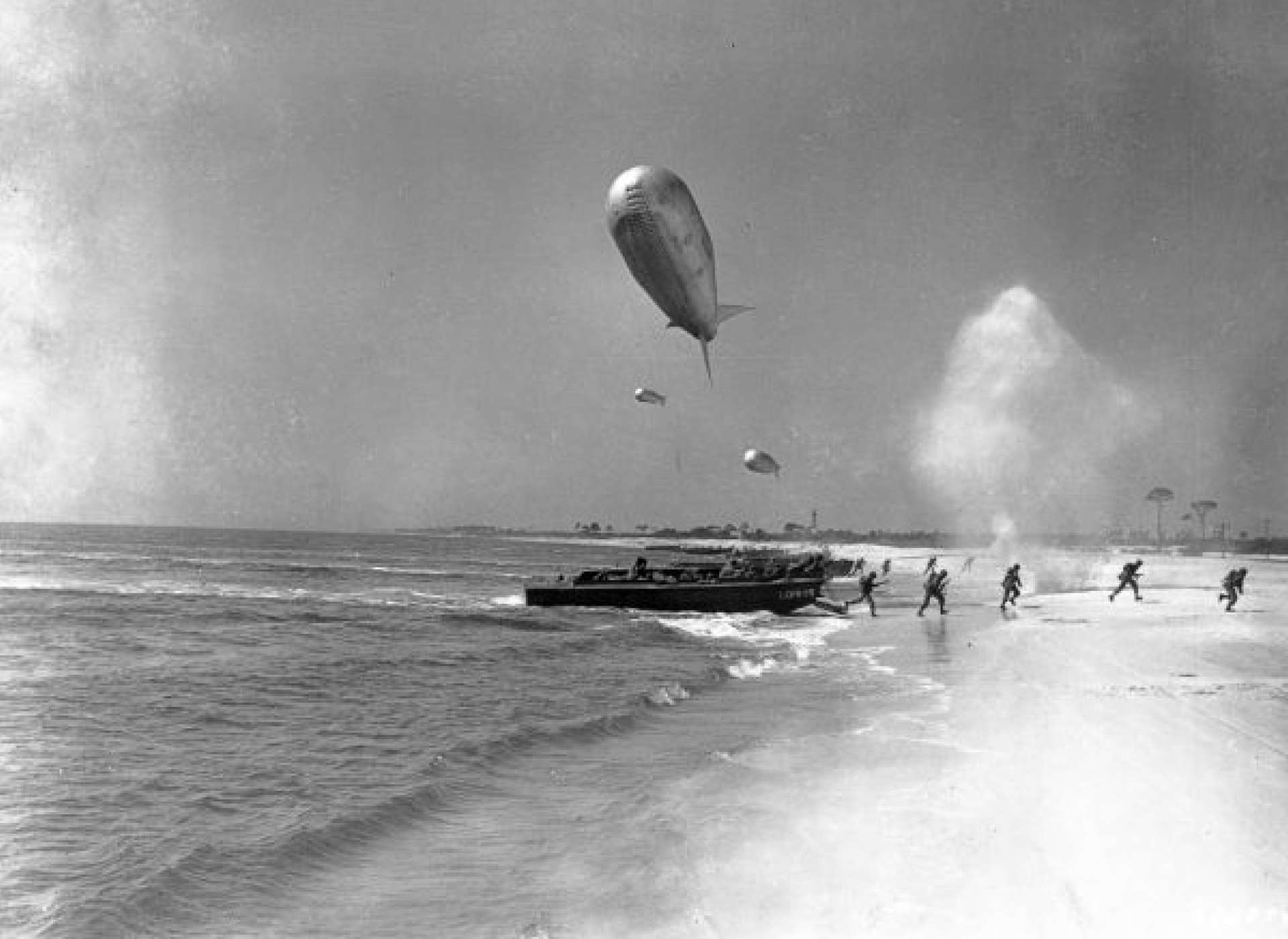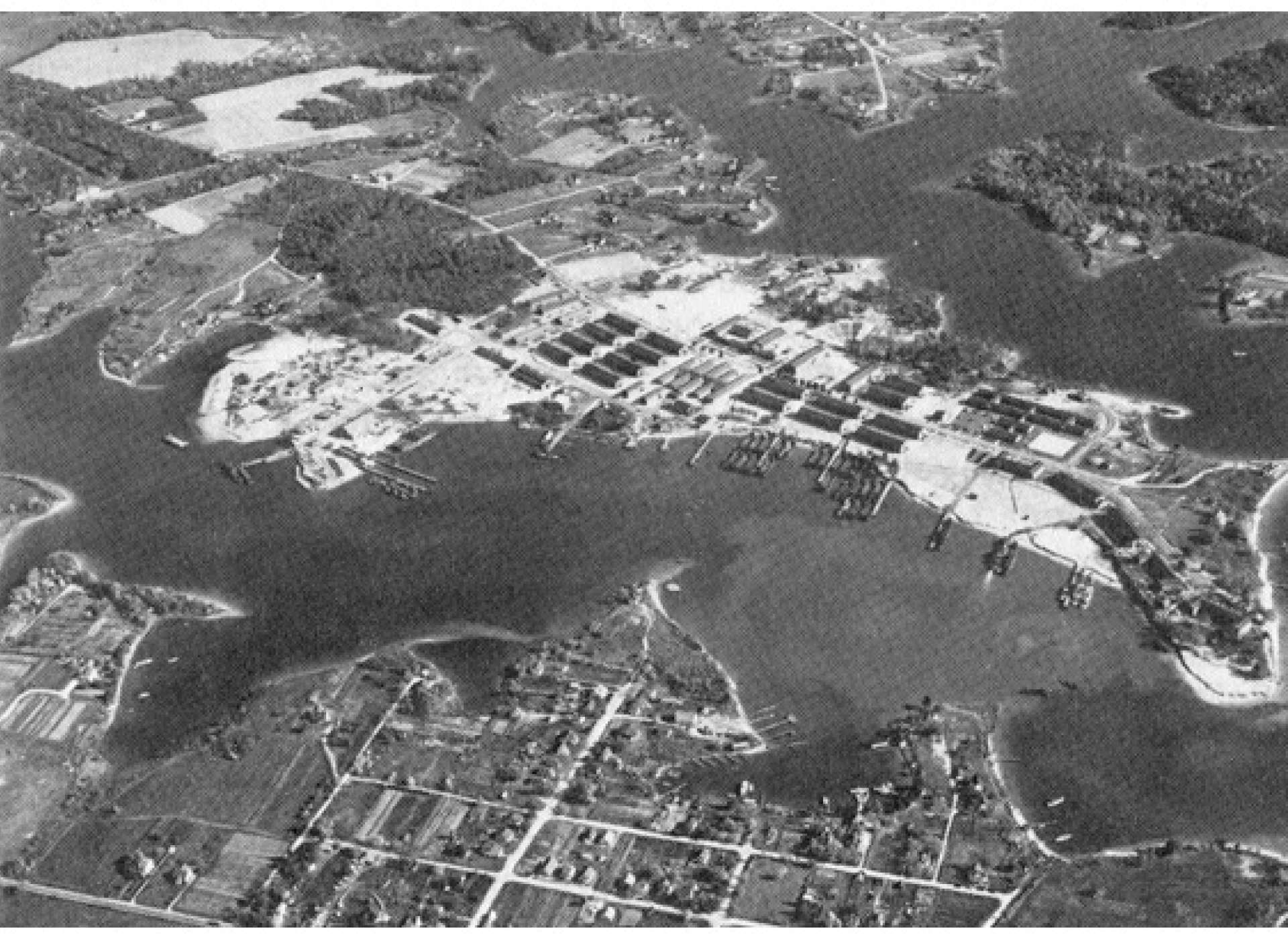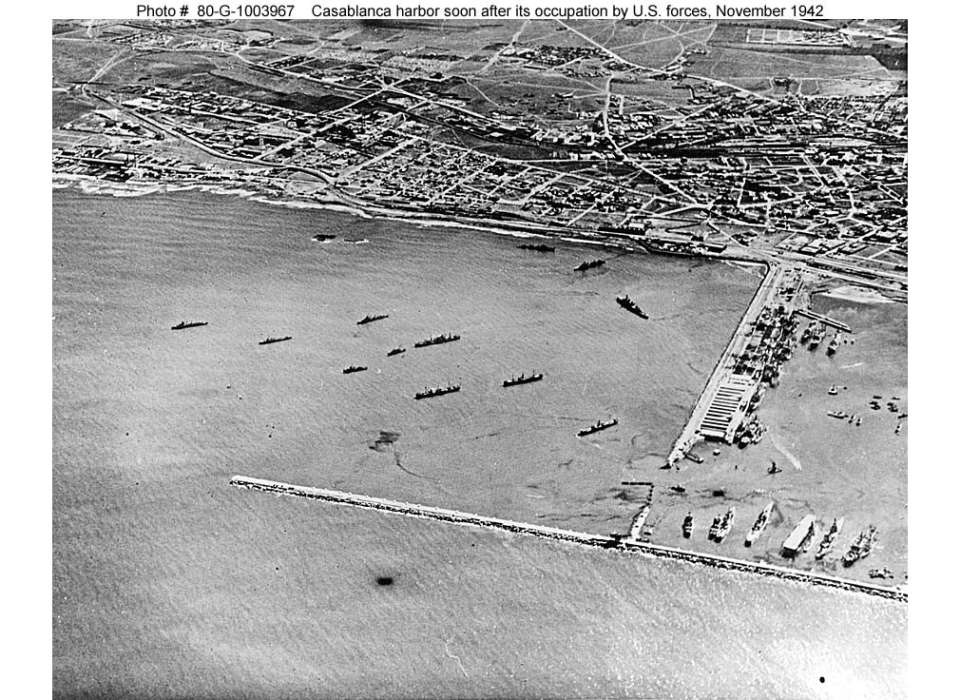Top image: US vessels in the port of Casablanca, November 1942. (US Navy photo)
The Allied victory against the Axis was a long journey—one that actually took much longer than the war itself. Liberating the continents of Europe and Africa required the projection of powerful ground combat forces overseas and then landing them in the face of heavily defensed shores. Development of this amphibious assault capability took years to develop, with much of the work done even before America’s entry in the war.
The movement of men and material into dangerous surf zones while under enemy fire requires significant skill, organization, and competence at every level—something the Americans had already been working on prior to the war. Such a complex undertaking required the development of amphibious doctrine, equipment, and practices. While the Americans specialized in the evolution of amphibious operations, it took years to develop and was often a fraught, disjointed, and troublesome process.

US Troops landing in French Morocco, November 8, 1942, as a part of Operation TORCH. Despite very little experience with amphibious operations, the US Army conducted nine separate landing at three different objective areas. (US Navy Photo)
For over four decades, the US military grappled with the problem of modern amphibious operations. During the Spanish American War of 1898, US Navy and Army forces captured the enemy fortifications at Santiago, Cuba, by amphibious assault. Although victorious, Army and Navy forces were not on the “same sheet of music.” The landing was poorly planned, coordinated, and executed because the respective commanders focused on their own missions without consideration of the joint fight. With an unclear chain of command, the operation was further hampered by disorganized ship-to-shore movement, incomplete intelligence, limited naval fire support, and ineffective communications. While US forces prevailed at Santiago, it became clear that more work was required if the nation was to project combat power overseas and over the shore.
In 1903, President Theodore Roosevelt, a veteran of the Spanish-American War, sought to address the lack of coordination between the services and established a Joint Army-Navy Board. Designed to facilitate planning and discussion between the two services, Roosevelt was not alone in his displeasure over service-centric parochialism. As the US gained overseas possessions, it also assumed a responsibility to control and defend them. In 1907, Commander H. S. Knapp, an instructor at the Naval War College, curtly argued that security of American overseas possessions:
“could not be assured by a navy alone, or by an army alone; hereafter the two services must work together.”
Knapp argued further that a navy must secure safe passage of troops, protect and assist in the debarkation of troops, and secure the lines of communication and assist in a “tactical way.” He also chastised those who maintained their service parochialism calling them, “jealous, narrow-minded men.”
In 1913, Secretary of the Navy Josephus Daniels directed the Marines to conduct exercises on the island of Culebra and Vieques, near Puerto Rico. These exercises were to test and develop what was referred to as “advance base concepts.” While these small experiments were useful in thinking about expeditionary operations, American attention soon shifted to the conflict in Europe and the focus on sustained land operations. Additionally, the United Kingdom’s experiences in World War I only further solidified the idea that amphibious assault was suicide because of the introduction of airplanes, deadly artillery, and automatic weapons. The recent experience failure at Gallipoli served as primer of how modernization made amphibious operations obsolete. However, not everyone agreed.
After the war, the Marines renewed their interest in amphibious assault as they looked to establish a niche within the American defense establishment. In 1921, Marine Commandant Lieutenant General John Lejeune tasked his talented and industrious subordinate, Major Earl “Pete” Ellis, to analyze amphibious requirements in preparation for a war with Japan. Based upon his travels in the Pacific, Ellis published OpPlan 712: Advance Base Operations in Micronesia. His research helped frame the problems of modern amphibious assault.
In this document he outlined material requirements, methodologies, and suggested organizational structures needed for such operations. Written years before America’s entry in the World War II, Ellis’s ideas served as the foundation for American amphibious doctrine. The Marine Corps continued its study of amphibious operations by conducting fleet exercises, refining concepts, having students in its professional schools study various scenarios, and experimenting with ship-to-shore conveyance methods. In 1934, the service published the Tentative Landing Manual that served as the starting point for American amphibious doctrine.
The US Navy codified the Marine concepts in Landing Operations Doctrine, Fleet Training Publication Manual 167 (FTP-167). In this document, the naval services outline six critical components of an amphibious assault: command relationships, ship-to-shore movement, naval gunfire support, aerial support, beach head establishment, and logistics and communication.
By 1941, the Army also adopted FTP-167 as Field Manual 31-5 Landing Operations on Hostile Shores (FM 31-5). The naval services concentrated upon the war plans in the Pacific with FTP-167 focused upon the seizure of relatively small islands. It did not specifically address the character of warfare the Army would face in Europe and North Africa; FM 31-5 provided a starting point but fell short of addressing the Army’s campaign requirements. After entry onto a landmass, the Army would then have project power further inland on a continental scale. This was a much different requirement.
While the US Army’s new FM 31-5 specifically called out the need for joint operations between the Army and Navy, the two services were hardly used to working together. Just prior to America’s entry into the war, the 1st and 3rd Infantry Divisions along with the Navy conducted amphibious assault experiments on both coasts. However, these amphibious training operations were poorly executed by both services. Troops were landed on the wrong beaches (sometimes even outside the training area), communications between units and the services were problematic, and logistics support was often ineffective. One evaluation report sent to Army Chief of Staff George Marshall stated, “…amphibious operations up to this time had been so deficient that a real operation against a competent enemy could only end in disaster for American forces.” Nonetheless, with war clouds on the horizon, American war planners recognized the need for a forcible entry capability was urgent.
In 1940, the Army Corps of Engineers began addressing the technical issues associated with amphibious operations with the Army ordering two divisions be trained in littoral operations. The Army realized that it also needed special amphibious engineer battalions to clear obstacles, conduct reconnaissance, and destroy fixed positions. In March 1942, the Army also established Engineer Amphibious Command (EAC) to train soldiers for boat operations, maintenance, and shore party duties. Looking for experienced personnel, the Army distributed circulars to yacht and boat clubs while also advertising in Motor Boat magazine.
In July 1942, the Army established its first Amphibious Training Center at Camp Edwards, Massachusetts. Not only would this location be used to train the new engineer brigades, but the camp provided initial training for amphibious infantry divisions. Additionally, Camp Edwards served as a test location for new and innovative amphibious equipment.
Accompanying Camp Edwards, the Army also established Camp Carrabelle, Florida, as an additional amphibious training base. Built in a swamp, the Florida location was so miserable and unpopular that General Omar Bradley quipped, “…the man who selected that site should be court martialed for stupidity.” While the use of these bases for infantry training was short lived, they marked the beginnings of the Army’s appreciation for the complexities of amphibious assault and the requirement for formal instruction.

Army troops practicing amphibious operations at Camp Carrabelle, Florida. (Florida State Archive)
For its part the Navy also began investing in amphibious training. Near Norfolk, Virginia, the Naval Operating Base under Admiral Kent Hewitt established joint training programs for communications personnel, coxswains, and fire control parties. Soldiers and sailors at Little Creek, Virginia, also attended the “Shore Party School” that trained men in the art and science of organizing a beachhead, receiving men and equipment, then moving both forward. A Transportation Quartermasters School helped Army officers understand the process and science of loading equipment onto naval vessels. While subject to naval oversight for the ship’s trim and stability, Hewitt believed the configuration of men and equipment aboard was an Army responsibility.
Additionally, the US Navy established an amphibious base at Solomon’s Island, Maryland, dubbed the “Cradle of Invasions.” With three assault beaches, the Maryland location trained half a million men. Furthermore, to assist in the development of naval surface fire support, the Navy acquired Bloodworth Island in the Chesapeake. This range was the first of its kind and allowed Navy gun crews to refine their skills supporting troops ashore.

Solomon’s Island Amphibious Training Base Maryland. Termed the “Cradle of Invasions,” this was an important link in the development of American amphibious capabilities in the European Theater of Operations during World War II. (National Archives)
By late 1942, the US military had come a long way from the haphazard assaults conducted during the Spanish-American War. While there was still much to learn regarding amphibious assault and joint operations, the exigency of World War II served as a catalyst for the War and Navy Departments. This learning curve was steep and would continue for the next few years. Tough lessons would be learned the hard way—during combat—and would take place shortly in November 1942 during Operation TORCH and the Allied assault into French North Africa.
John Curatola, PhD
John Curatola, PhD, is the Samuel Zemurray Stone Senior Historian at the Jenny Craig Institute for the Study of War and Democracy.
Cite this article:
MLA Citation:
APA Citation:
Chicago Style Citation:





![Max Fuchs, New York City cantor, sings as Rabbi Sydney [sic] Lefkowitz, Richmond, VA, conducts the first Jewish services from Germany.](/sites/default/files/styles/max_650x650/public/2025-10/image1.jpg)



